The Wild Flowers of Skopelos
Blog
For those who love Skopelos and the wildflowers of Greece
The Wild Flowers of Skopelos
Blog
For those who love Skopelos and the wildflowers of Greece
The Wildflowers of Skopelos is for those who love the island of Skopelos and the wildflowers of Greece.
There are now over 350 flowers and trees and also information on the island, its floral landscape, geology, climate, and ecological habitats.

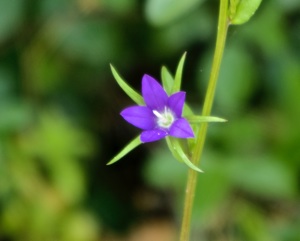
Succulents
Παχύφυτα
4 Sept 2022
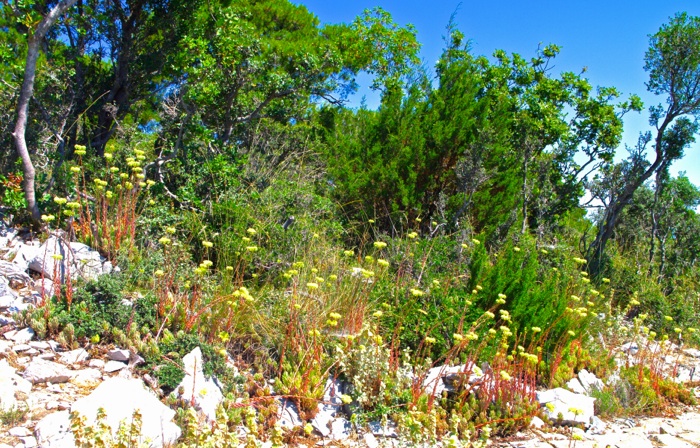
A number of wild plants which grow on Skopelos belong to a special group known collectively as succulents. They have developed a spectrum of special adaptations, which enable them to survive long dry periods.The main characteristic and the one which results in their succulent juicy nature is the ability to store excess water in their cells, which have elastic cell walls. The water can be stored in any parts of the plant, stems, the leaves, or in the roots and sometimes water is stored in all parts of the plant. The leaves are thickened and often have a waxy surface; they have fewer, smaller stomata, the microscopic holes on the underside of leaves, a feature that reduces water loss. Another common feature is a shallow network of fine roots which allows the plants to take up water after the short, sharp showers.
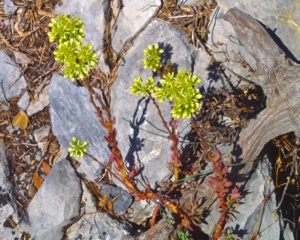

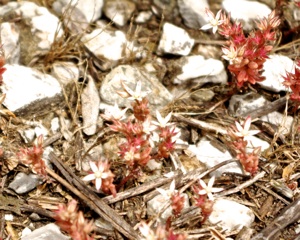
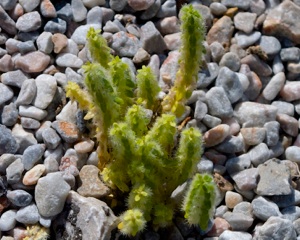
Succulents have however not only developed physical adaptations but have also developed a unique form of metabolism. All plants, to produce energy, by breaking down the sugars, created by photosynthesis, in most plants this produces carbon dioxide and water which is released via the stomata at night. Succulents use a different metabolic pathway and instead of forming water and carbon dioxide a weak acid is produced, thus preventing water loss.
Succulents often emerge in situations which one would imagine are hostile to plants, on sandy beaches, on bare rock faces, in the gravel at the edge of roads and from the cracks in dry stone walls. They come in a variety of curious shapes, or interesting forms and colours. They make attractive indoor plants and are ideal as waterwise plants for Greek gardens.
Six recently added plants are all succulents, though not all related, they have evolved similar traits to survive in hot dry conditions.






Click on plants to visit their page.
White variants
Άσπρες παραγαλλές
White is not simply the absence of colour,
but the reflection of every colour of the rainbow.
2 Aug 2022
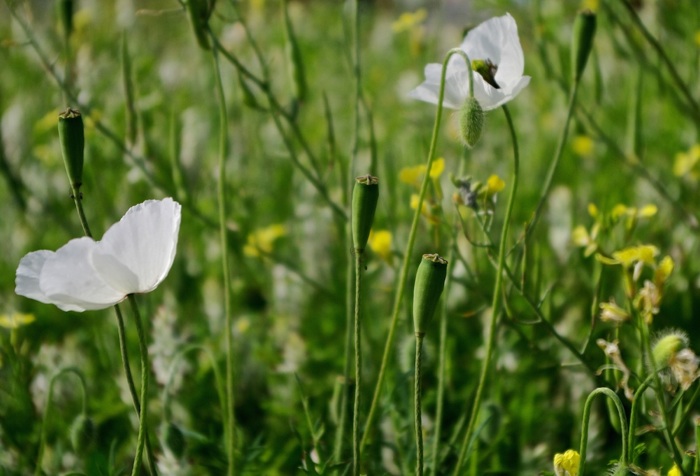
There are many plants which normally have white flowers but we all think of poppies as red, mallow flowers as pink, thyme (Thymbra capitata) as bright purple and pyramidal orchids in all shades from deepest magenta to palest pink, but occasionally amongst these plants a white individual will appear. Very occasionally very pale pink poppies emerge.

In contrast to the definition of white given above, white colour results from an absence of the pigment, which usually gives the flower its colour. As a result the petals do not only reflect a small portion of the visible spectrum, but every colour of the rainbow.
The white variants are a result of recessive inheritance; the coloured forms having dominant inheritance. White forms are usually rare but the frequency of the recessive gene increases in a population so the white variants become commoner.
A number of these variants have been found on Skopelos; they are given the epithet var. albiflora.* They are not albinos, although albino plants do occur in nature; in albinos the whole plants, including the leaves, are totally devoid of pigment; in albiflora variants only the flowers - petals or sepals are white and sometimes also the stamens and stigma. As you walk through the fields and forests of Skopelos, look out for these special plants.




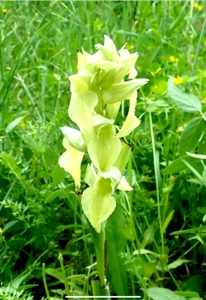
A particularly beautiful albiflora variant was found by my fellow amateur botanist Kjell Thovsen - Serapias codigera var. albiflora. it is not pure white but palest yellow. For more of his flowers go to: Skopelos Flora
Photo by Kjell Thovsen.
*The term variant or variety is not universally accepted but it is used here as the website is arranged by colour. All the var. albiflora plants have been placed on the white page except the white Anacamptis pyramidalis, which is included with the orchids.
More than 350 flowers and trees
The term succulent derives from the latin adjective succulentus meaning juicy,
sucus being juice.